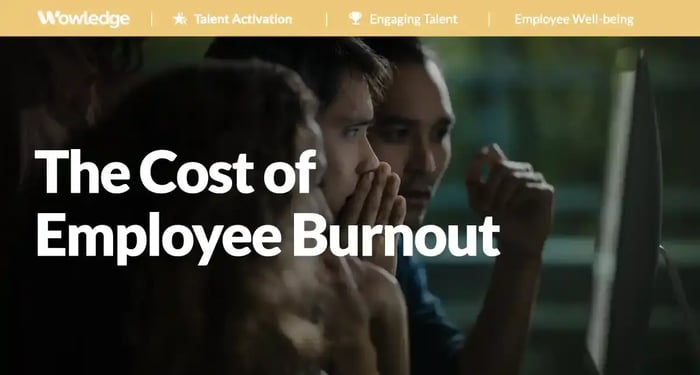Table of Contents
- Understanding employee financial wellness
- The realities for workers and their employers
- The benefits of employee financial wellness
- Building the foundations for employee financial wellness
- Establishing comprehensive programming
- Program design considerations
- Provide a range of practical solutions
- Relevant Practices & Tools
- About Wowledge
Over the past twenty years, major disruptions and fluctuations have occurred in global economic markets. The first was the global financial crisis of 2008, followed by the pandemic-related recession of 2020. Inflationary pressures started in 2021, and the tariff-driven trade war designed to reset global trade imbalances is driving consumer prices up. Workers trying to balance their inflation-impacted paychecks with rapidly increasing consumer costs are caught in the middle. Even with high levels of turnover and job switching to offset these forces, layoffs have increased, and hiring rates have declined, creating undue pressure and financial insecurity on workers at all income levels. Employee financial wellness has taken center stage as a concern, as people look to their employers for help and support.
The broader financial market picture is filled with pain points, as market fluctuations are driven by, or respond to, a significant wave of bad news, including:
- Consumer costs continue to rise due to inflation and tariffs
- Costs of borrowing remain high after years of low single-digit levels
- Savings and retirement funds are dropping due to investment market downturns
- Home buying is increasingly a stretch or out of reach for many
- Long-term student loan repayments remain a heavy burden for many
- Healthcare and childcare cost escalations continue
Workers across the board are feeling the pain, with 68% of U.S. employees reporting financial stress impacting nearly every aspect of their lives, particularly in younger workers. Consider also that the average student loan debt is as high as $41,618, and the average parent spends 22% of their household income on child care.
Given the distraction that financial stressors represent for employees, organizations should look to support or help employees through these challenging economic times to avoid those that interfere with employee performance and productivity at scale. Financial wellness strategies offer a tangible way to address these pain points and keep workers focused on contributing to achieving organizational objectives.
Understanding employee financial wellness
Financial wellness (or "well-being") is how well employees can comfortably balance their income and financial obligations while investing in their future, creating a sense of security for them and those who rely upon them. Creating that condition requires strategies, behaviors, and actions such as budgeting and saving to secure the stability necessary to successfully “ride the waves” of inevitable economic and personal shifts, changes, and circumstances. It is favorably compared with personal wellness (e.g., physical and psychological), as it is “not an end state or final destination but, rather, a way to live day to day."
The Consumer Financial Protection Bureau (CFPB) has defined four elements of financial wellness that create a matrix of wellness characteristics (security vs. freedom of choice) and timeframe (present vs future). This is a valuable method for understanding and evaluating the extent to which an individual is or is not experiencing financial wellness, and where opportunities to improve it can be identified. It simultaneously balances the need to plan and act for comfort today and security tomorrow, and offers clarity as follows:
- Security: Having control over day-to-day and month-to-month finances (present) and having the capacity to absorb a financial shock (future).
- Freedom of Choice: Having financial freedom to make choices that let one enjoy life (present) and being on track to meet long-term financial goals (future).
When these exist in harmony, they provide financial security and psychological safety, acting as a barrier against many uncontrollable circumstances that adults face. While they can get out of balance due to unforeseeable events, such as a global economic disturbance, climate event, or job loss, they can also emerge from a lack of understanding or planning for the financial consequences of others such as a significant illness or child birth, job transfer to a new city, or taking on a significant expense such as a new home. In each case, the better informed and prepared one is, the more likely they will be able to “weather the storm.”

The realities for workers and their employers
Many are struggling
A surprising number of workers are having difficulties balancing their income with indebtedness and savings with expenses. Widespread reports of frequent job-hopping (e.g., “The Great Resignation”) for better pay, benefits, and career opportunities, and several years when new hire wages were rapidly rising, workers seemed to have the advantage over employers, leading many casual observers to perceive the opposite.
However, insights into financial struggles come from research conducted by financial services companies, such as that from Bank of America, which found that 59% of employees live paycheck-to-paycheck, 41% are unable to pay off credit card balances every month, and only 19% report being on track with their retirement savings.
Compounding or perhaps explaining the problem for many is that 25% of Gen Z and Millennial workers hold student loan debt, averaging $41,618. Savings rates are affected, with only 14% having set aside enough for a new home (24% for first-time buyers), 16% with enough to pay for college or private school, and only 32% having sufficiently saved for planned major expenses (e.g., vacation or wedding).
Financial literacy is poor
The knowledge required to manage one’s money, spending in the short term, and saving for the long term effectively is also hampering many across the workforce. An annual survey that tests people’s understanding of the drivers of and how to achieve financial wellness showed that personal financial literacy is generally low. For example, on average, U.S. adults could only correctly answer 48% of the 28 index questions.
While 58% correctly answered questions about borrowing (loans), only 44% got questions on investing right, and 42% related to insurance. Perhaps more worrisome is the finding that only 35% could correctly answer questions on financial risk, indicating that they have difficulty ascertaining when they are or might be headed towards financial trouble. And the lowest scores were seen amongst the younger workers, where only 37% of Gen Z and 30% of Millennials could correctly answer the questions, and female financial literacy continues to lag that of men by 15-27%.
The issue? People with low financial literacy are more than four times (4X) likely to have difficulty making ends meet in a typical month, and nearly three times (3X) likely to be debt-constrained. They are also more than three times (3X) as likely to spend 10 hours or more per week on issues and problems related to personal finances, half of which happen during their scheduled work hours.
Employee behavior and action are insufficient
The impacts of these financial challenges are evident in employee behavior, where choices are being made to bypass opportunities for learning or taking advantage of employer programs. For example, one study found that only 63% of workers participated in available financial education and planning programs, only 56% used Health Savings Accounts (HSAs), and 36% used student loan/tuition assistance. These stand in contrast to higher employee participation rates in health insurance (82%), retirement plans (90%), pensions (81%), and life insurance (74%).
Employees are also reducing their longer-term savings rates, with 25% of employed adults doing so due to inflation, and half stopping all retirement savings completely. This is related to 30% of workers who report that making ends meet is difficult and 26% who state that they are debt-constrained.
Employers are concerned
Organizations are increasingly concerned about the impact on employee performance, productivity, and general well-being. 75% of organizations report that their workers’ financial stress negatively impacts their operations and objectives. 63% of companies state that this also contributes to increases in their healthcare benefits costs.
33% of employers say the stress negatively affects individual workers' productivity, and 10% report that the stress is resulting in poor performance and more mistakes at work. The stress is coming from reports from their employees of saving enough (62%), having enough to retire (58%), paying off debt (47%), having funds set aside for relaxation and pleasure (47%), and affording basics or essentials alone (42%). An interesting aside is the finding that only 33% of those employees used a financial planner in the past year.
The percentage of employers who offer financial benefits and literacy support designed to help their employees better manage their money and future requirements is relatively low. For example, Transamerica reports that while 77% of workers view financial wellness programs as an essential benefit, only 28% of employers offer them.
However, even when companies offer such programming, employee utilization rates tend to be low. One study found that amongst the 34% of companies that view education and planning critical to employees' financial well-being, only 18% of their employees agreed. In contrast, PNC Bank found that while 36% of employers offer financial education, only 32% of their employees participate.
The benefits of employee financial wellness
Some organizations may find the cost of providing employee financial wellness benefits, services, and platforms a barrier. However, many existing benefits providers (retirement and 401K, employee assistance programs, and healthcare benefits) already offer services, tools, and support that can be leveraged and promoted. At the same time, a business case can be built based on organizational research that finds benefits come from providing such support. For example, PWC found that financially-stressed workers are 22% more likely to quit than their non-stressed peers, and were 18-25% less engaged.
Another study found that 90% of private corporations reported that employee personal finance issues were impacting their employees’ overall job performance, with 38% saying that the impacts were “very” or “extremely” harmful. The value of having support for handling their financial affairs is especially significant with younger workers, as 92% of Gen Z, and 85% of Millennial employees report a higher likelihood of staying with the employers who offer such benefits.

Building the foundations for employee financial wellness
Providing support for employee financial wellness starts with understanding its essential elements. It requires a comprehensive view of the core aspects of personal financial wellness, strategies to balance the “now” and “tomorrow”, and tools, resources, and methods to help employees adjust to changing circumstances and lifecycle demands. The foundations should establish knowledge and skills development that support employees when they face common, and often inevitable, challenges related to managing the costs of living, health care, child care, daily living expenses, budgeting, and money management.
The fundamental knowledge and skill elements of employee financial wellness include:
Budgeting and financial planning focus on balancing current income level with required (e.g., housing, food, transportation, clothing, healthcare, childcare) and preferred (e.g., vacation, social, recreational) financial obligations.
Savings and emergency funds relate to building shorter-term reserves for managing unexpected financial emergencies (e.g., accident or injury, job loss), and expected periodic payments (e.g., insurance deductibles and co-pays, vacations, auto replacement).
Managing debt incurred from credit cards and loans (auto, home, education, medical), including managing credit ratings.
Investing to fund planned, longer-term purchases and life-stage based needs and preferences (e.g., home purchase or renovation, college, new business start-up, retirement).
Controlling risk from potentially significant events, occurrences, or disasters through insurance or emergency funds (e.g., life, long-term care, home, flood, fire, hail, auto, theft, and asset loss).
Establishing comprehensive programming
An employee financial wellness strategy should address not only the necessary knowledge and skills but also acknowledge the human or emotional elements involved in managing personal finances. Employees (and their partners and dependents) are often frustrated, disappointed, and even embarrassed when they face financial difficulties or barriers to achieving what they believe they need, deserve, or “should have.” 68% of surveyed employees report that financial stress is negatively impacting their mental health, and 51% say it is causing physical health issues.
Employee financial wellness programming should help employees:
- Understand their financial situation: Have a clear picture of their income, expenses, debts, and assets.
- Make informed financial decisions: Learn to budget, save, invest, and manage debt within earned income limits.
- Create a plan to achieve financial goals: Determining personal goals that are realistic, achievable, and a “stretch” in the short, medium, and long-term. These can be broken down into “must-do” and “want-to-dos”. They include savings for retirement, paying for education, purchasing a home, taking a vacation, or buying an investment property.
- Manage the emotional aspects of finances: Financial wellness also involves managing stress, anxiety, and other money-related emotions.

Program design considerations
When developing or enhancing an employee financial wellness program:
1. Understand the impact of financial stress
Evaluate how financial stress affects employee productivity, performance, discretionary effort, contributions, and retention. Communicate that to leaders and managers to build a business case and support for benefits and programming.
2. Make private options available
Provide confidential options to employees who may be embarrassed to participate in educational or skill-building programs with or in full view of their peers. Lower participation rates that are typically seen may be due to the prevalence of group presentations, classes, and coaching sessions that many fear will expose them as needing help.
3. Tailor support options
Customize financial wellness support to meet the varying needs of employees at different income levels, life stages, family and dependent responsibilities, and life goals. Understand that “one size does not fit all, and employees have differing needs and appetites for support. Consider that different benefits can become either more attractive (e.g., child care or enhanced retirement savings) or available as careers progress, creating a need for tailored programming. Examples include newlyweds, new parents, empty nesters, or when they become eligible for annual bonuses, stock options, or specialized perquisites (“perks”).
4. Listen to what employees want
Use employee listening and design thinking approaches to understand their pain points and create programming that directly addresses those. Insights into employee preferences come from the PNC Bank research, which directly addresses many practical challenges and issues that many employees report in other studies. For example, 53% of surveyed employees would like access to emergency savings accounts, 44% to financial planning services, 40% to financial education, 39% to stock or equity compensation plans, 34% to student loan financing and repayment assistance, and 31% to early paycheck funds (or “earned wage access”).
Provide a range of practical solutions
Rely on a comprehensive range of solutions to support employees at every stage of their lives and careers. They should ideally encompass learning, support tools and resources, and employee benefits plans, whether accessed through existing benefits providers or as an added service from new vendors. Ideas and examples of best practice offerings include:
- Financial literacy educational programs with instructor-led or eLearning classes focusing on budgeting skills, managing pay and cash flow, savings strategies, debt management, building credit, risk management, and long-term investing.
- Guidance and resources on best leveraging available spending accounts, which are employer-sponsored pre-tax spending accounts related to eligible expenses not otherwise covered by insurance for health care, dependent care, wellness, and dental, vision, or preventative care.
- Online calculators, tools, and resources for financial planning, investment simulations, and modelling budgets, savings, benefits, costs, and net pay after pre-tax deductions are applied to eligible health or retirement costs.
- Automatic savings plans that employers offer to encourage and support employee savings for retirement (e.g., 401K, Roth IRA), college (e.g., 529) through payroll deductions or special or rainy-day needs (e.g., vacations, down payments) through direct deposits into an employee’s personal bank accounts.
- Specialized benefits designed to support employee financial management needs, including “earned wage access” (now available through some HRIS and payroll providers), discount purchasing programs, student loan repayment assistance and refinancing options, lifestyle spending accounts (LSAs), and benefits related to commuting, pet insurance, or family-related (fertility, adoption, childcare) expenses.
- Employee resource groups that are organized and charted as special interest groups providing education and support with targeted speakers, reading, resources, and support. These bring similarly situated and-minded employees together for a combination of expert and peer learning around topics of common interests, such as a single parents' financial planning support group, or a young employee investment group.
- Access to financial advisors and coaches that are increasingly requested by workers seeking to get tailored and expert guidance on managing student loan payments, saving for retirement or a house, investing wisely, and taking advantage of various company benefit plans and programs.
- Employee financial wellness platforms have emerged that offer a variety of learning resources, tools, guidance, and even digital banking services. While each has a unique blend of capabilities and services that require proper vetting and evaluation before providing access to employees, they provide a value proposition that small-to-mid-sized organizations might find attractive as a one-stop offering. Examples include Nudge-global, Chime.com, Youmoneyline.com, and Wellable.co, LearnVest, Hellowallet, and Smartdollar. Nonprofit providers such as GreenPath Financial Wellness and Enrich.org are also suitable and worthy of consideration.
Relevant Practices & Tools
Emerging Workplace Wellness Practices for Culture and Brand Activation. >
Because of its importance to the broader community, “Wellness” can be integral to the organization’s brand. These aren’t only health-related brands... more »
Engaging Employees to Co-create Wellness Solutions that Increase Engagement and Promote Enduring Practices. >
Traditionally, the decision of what wellness programs to offer employees comes from behind the closed doors of the HR function, often sitting with a benefits manager... more »
Communicating the Investment in Compensation to Stakeholders and Employees. >
Organizations allocate significant yearly funds to attract, develop, and retain talented, skilled, and diligent labor... more »
Designing a Long-term Incentive Plan for Key Roles to Foster Desired Future Outcomes. >
Organizations have identified the many benefits of paying for performance while focusing their organizational structure on long-term success... more »
The Total Compensation Statement Template: Outline and Present the Major Components and Financial Value of an Employee’s Pay and Benefits. >
The Total Compensation Statement (TCS) is an individualized document that outlines the major components and financial value of an employee’s pay and benefits... more »
About Wowledge
Wowledge is the implementation-first platform designed for lean HR teams and consultants who need to design and scale strategic HR programs efficiently—without starting from scratch.
Our members gain access to continuously updated best practices, step-by-step guidance, expert-built tools, and customizable templates—all structured to accelerate the development and implementation of key HR programs.
Recognizing that every organization operates at different levels of sophistication, Wowledge’s scalable system of best practices follows a stage-based approach—Core, Advanced, and Emerging—ensuring HR professionals can implement solutions tailored to their organization’s unique needs and goals.
Your Shortcut to Amplifying HR Impact!
Get started for FREE! Learn more.










